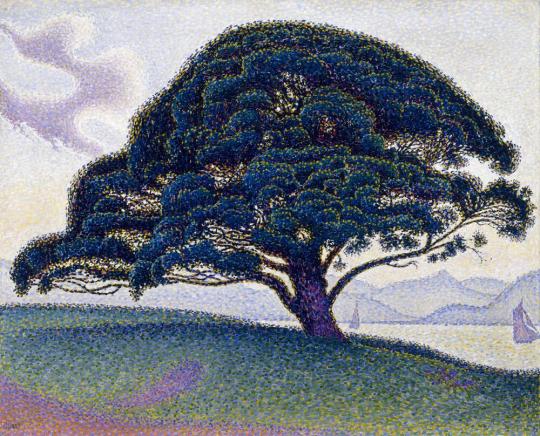The Bonaventure Pine is a Pointillist masterpiece by artist Paul Signac. Created in 1891, it is one of the most recognized works of this Post-Impressionism art style. The painting features a large pine tree in the center, standing tall against an azure sky and surrounded by small patches of grass and shrubbery. The use of the Pointillism art technique gives the work its unique look, as each dot creates a subtle texture to the landscape.

Signac was inspired by his travels around France, particularly along its Mediterranean coast. This influence can be seen in the vivid colors of blues and greens used throughout The Bonaventure Pine. A signature element associated with Signac’s work is visible here, too – bold outlines surrounding each object to separate them from their surroundings while maintaining unity across the canvas.
Paul Signac’s Inspiration for the Painting
Contents
Paul Signac was one of the most recognizable painters in the Post-Impressionism movement. His works are known for their bold brush strokes, bright colors, and unique compositions. He is best known for his Pointillism technique, which uses tiny dots of paint to create an overall picture.
Impressionist masters like Claude Monet and Auguste Renoir and Neo-Impressionist artists such as Georges Seurat heavily inspired Signac’s work. His paintings often featured everyday life scenes, focusing on nature and landscape settings. He also experimented with light sources to create different effects in his work. In addition to painting, Signac was also an avid sailor and often drew inspiration from his travels at sea.
Colorful Elements of the Painting
One glance at a painting by French artist Paul Signac and you are instantly engulfed in an array of bright, vivid colors. An essential figure in the Post-Impressionist movement, Signac was one of the originators of Pointillism. This technique uses tiny dots of pure color to create a larger composition. His paintings are filled with a kaleidoscope of brilliant hues and unique shapes that immediately draw attention from viewers.
Signac’s most recognizable works feature shimmering blues, greens, purples, and oranges that almost seem to dance across the canvas. Often using harder edges than his pointillism contemporaries such as Georges Seurat, Signac created thick outlines for his colorful figures, which gave them additional texture and dimensionality. He often juxtaposed these bold shapes against muted backgrounds to bring out their vibrancy even further.
The Bonaventure Pine, painted by French Neo-Impressionist artist Paul Signac in 1888, is considered one of his most iconic works. This painting has long been admired for its vibrant colors and intricate details, but there’s more to this work than initially meets the eye. The Bonaventure Pine is a masterpiece with numerous symbols and references to contemporary social issues and Signac’s personal experiences.
Signac was known for infusing his paintings with symbolism, and the Bonaventure Pine is no exception. A closer examination of this piece reveals references to the French Revolution and industrialization during its creation period. The depiction of windmills in the background alludes to progress while nature remains untouched in the foreground – a symbolic contrast between artificial industry and natural beauty.
Critical Reception of the Work
The French Neo-Impressionist painter Paul Signac had a long and successful career, widely celebrated by his contemporaries. His use of Pointillism to create unique works of art was widely admired and praised for its innovative approach. However, critical reception for Signac’s work has been mixed throughout the years, with some praising him as one of the greats in Neo-Impressionism and others criticizing his tendencies towards academic painting.
Signac’s most famous works often go back to his earliest creations when he developed his signature pointillism style. While many praised this technique for bringing a new element to Impressionist paintings, some believed it was too reliant on scientific theories that lacked emotion. Despite this criticism, Signac continued to explore these techniques throughout his career while experimenting with color theory and other forms of abstraction.
You can see Paul Signac’s The Bonaventure Pine in Houston at the Museum of Fine Arts. It is part of the museum’s permanent collection, so it is always on display. The painting was completed in 1891 and is a classic example of Pointillism, a style of painting that uses tiny dots of color to create an image. The painting depicts a pine tree set against rolling hills and a blue sky. It is an iconic work of art that has been admired for its use of vibrant colors and intricate details.
Visiting the Museum of Fine Arts in Houston is an excellent way to experience this classic piece by Paul Signac. It is located in the city’s heart and offers visitors access to many other works worldwide. In addition to viewing The Bonaventure Pine, you can also explore the museum’s extensive collection of European art, American art, African art, and more.







